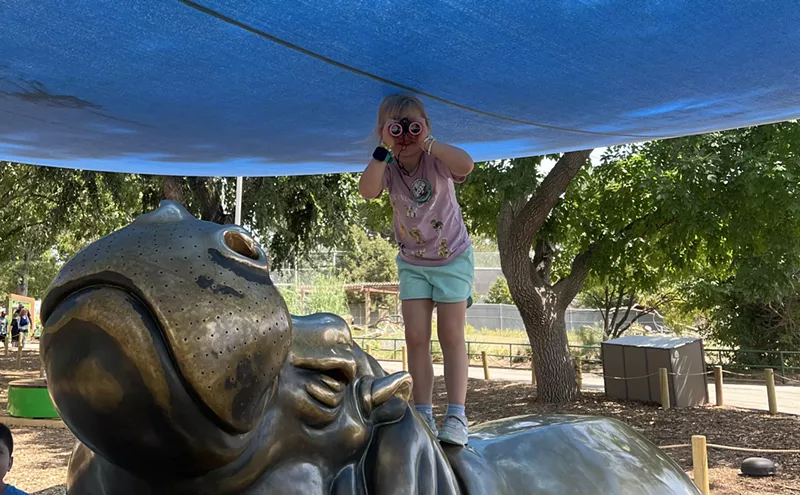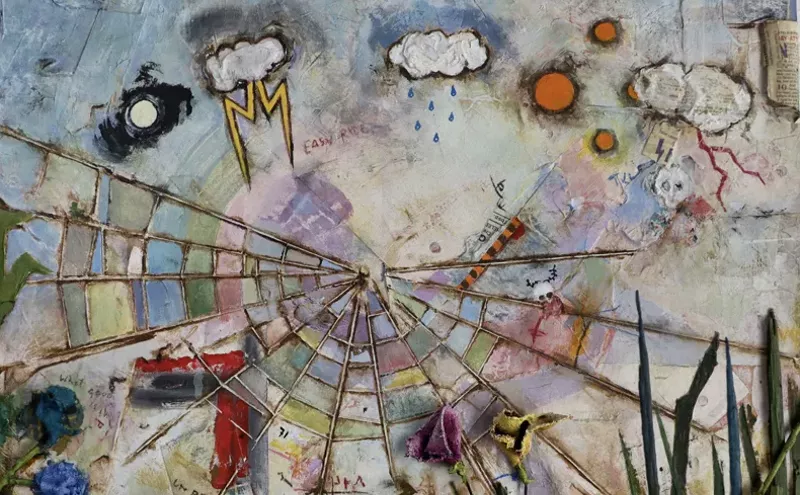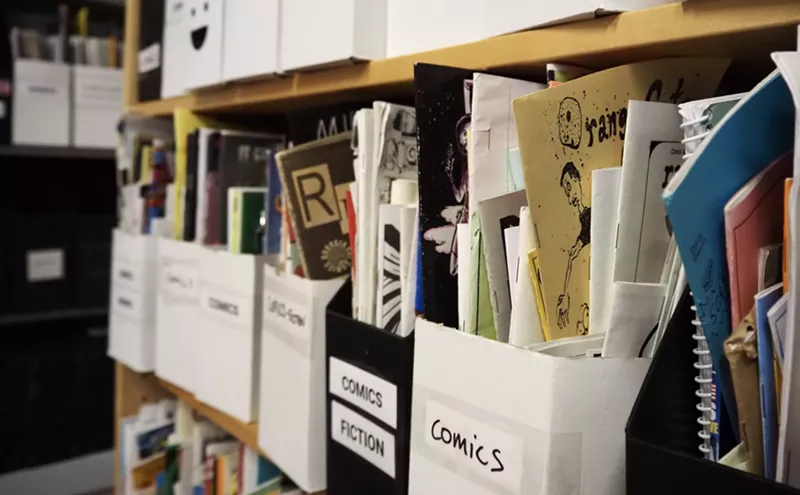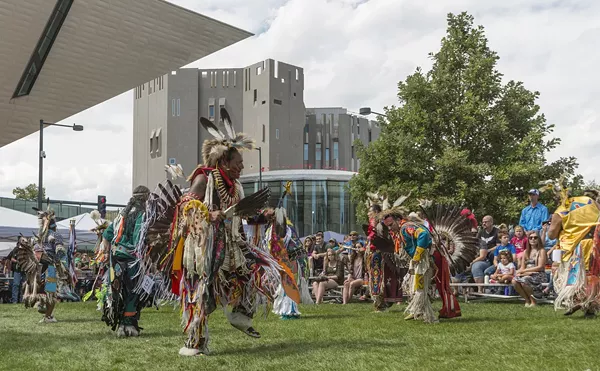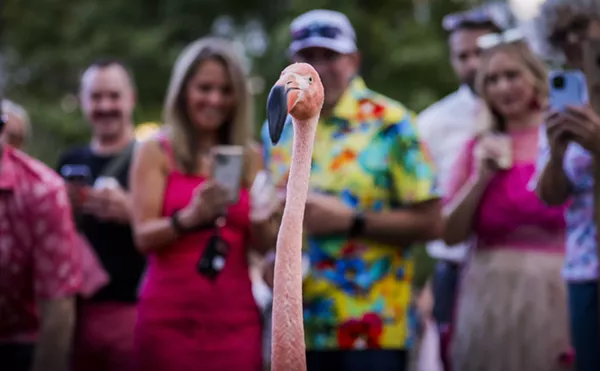Denver’s vibrant art culture has started to generate national attention, even getting mentioned as one of the town’s key attributes on all of those “best city” lists on the Internet. Although the Mile High City still has a ways to go in comparison to international art centers, it is nonetheless a regional powerhouse for contemporary art. Some of the hidden-in-plain-sight aspects of this success story are the people who made it happen. Among those are the artists who emerged in the 1980s and are still part of the mix today. This situation neatly sets up my subject: championing a pair of solos dedicated to veteran contemporary artists who have spent their entire careers in Denver.
First is an exhibit with the epic-poem-length title of I am not the same person that I was once before: a retrospective of works by Mark Brasuell, which is nearing the end of its run at the O’Sullivan Art Gallery at Regis University. Brasuell moved from Texas to Colorado in 1987 in order to work toward his master’s degree in fine art at the University of Denver. But even as a grad student, he began to participate in the local art world. At the time, he was mostly interested in performance and installation, but he soon turned to painting and drawing.
Brasuell emerged in the late ’80s and into the ’90s as a key player in the alternative art scene here, becoming one of the founders of the Edge Gallery co-op and then serving as its president for many years. He is currently a member of Spark Gallery, another old-line artist co-op. He has mostly eschewed associations with commercial galleries — though there has been an exception or two — preferring the freedom to do what he pleases, which the alternative spaces have allowed.
Though I’ve seen many Brasuell solos over the years, this is the first time I’ve seen the works he’s done over the past several decades put together in one place. I had two revelations from this experience. The first is that from his earliest mature work, dating from 1989, to the present, Brasuell has consistently embraced a pair of parallel signature styles: one for drawing, and a related though distinct one for painting. Although there’s an off-the-road moment here and there, almost everything follows one of these stylistic courses. Secondly, while Brasuell says he has based each of his series — and there are many of them — on emotional, political, personal and other narratives, this element is invisible to the viewer. That’s because he draws or paints the narrative out so that it is absorbed by one of these signature styles.
The drawings are instinctually composed of scribbled and rubbed-out abstract features that have been scattered across the oversized sheets of paper on which they’re drawn. Brasuell established this automatist, non-objective vocabulary as early as 1989, something that is exemplified by “Cut,” from one of his earliest series.
These drawings precede the earliest paintings, which were done a few years later. More clearly than the drawings, the paintings illuminate the reason that Brasuell’s content is difficult to detect. As noted, Brasuell invariably begins with a specific topic in mind, but the viewer can’t easily interpret it. That’s because the artist translates his feelings, thoughts and emotions concerning his family, his friendships, his political views and the like into color, movement and abstract form.
There are many marvelous examples of this play of elements — particularly in 1999’s “Down by the River,” in which the colors are beautifully blended, resulting in a windswept surface, and in “Punch Out,” from 2008, which features an unusual picture within a picture. Off to the top left of “Punch Out” is a panel of intertwined shapes in sunny tones set against the deep shades that are used for the rest of the panel.
The greatest of the paintings is the mural-sized “You and Me,” which is about Brasuell’s relationship with his partner, Aidan Gray. He’s covered the surface with arching shapes of luscious bright colors and inserted imaginary letters conceived by Gray into the overall composition. It’s really powerful.
I have only one knock on the show: It’s way too crowded. I wish that the works had been given more room (impossible at the O’Sullivan, since the display already fills the place), or that some pieces would have been left out.
The second solo I’m discussing is UN: Selected Works by Homare Ikeda, which also is dedicated to a longtime art-scene denizen. This handsome show is on display in the large community space at RedLine. Unlike the Brasuell show, the Ikeda presentation isn’t a career retrospective, even though Ikeda has likewise been at his craft for decades. Rather, it looks only at his most recent work — paintings completed this year.
Ikeda was born on a small Japanese island and moved to Colorado, via California, in the early 1980s. He studied at the University of Colorado Boulder, where he earned both a BFA and an MFA. He studied with many of the noted painters teaching there, but the influence of Kay Miller is particularly apparent in terms of Ikeda’s interest in piling on heavy daubs of pigment, which Miller is known for.
For many years, Ikeda reworked his canvases, sometimes laboring on a single one for years, adding more and more elements and painted passages. Then, during a residency at the Bemis Center for Contemporary Arts in Omaha in 2007, he had a breakthrough and pushed himself to knock out paintings more quickly. This continues to be the case, as he was able to come up with nine new paintings for this show, most of which are very large. Truth be told, however, he still revisits “finished” paintings, adding this or that, and surely some of these are the product of that process and will be subjected to his attention again once the show comes down.
The works on view represent a range of styles, including murky, all-over abstractions like “Un: Selected” and “Contradiction, I Exist,” both done in acrylic, oil and wax. The surfaces of these paintings are extremely lively, with lots of brush marks and built-up areas contrasting with the subtle compositions of vaporous and indistinct shapes. On the other end of his oeuvre are biomorphic abstractions like “Theater of Time” and “Mobility Is Visibility,” which are more thinly painted and include distinct shapes, bars and lines. The palettes in the two types of work differ as well: The all-over abstractions comprise thoroughly blended hues, with one color delicately giving way to another, whereas the biomorphic abstractions have hard and radical color shifts, setting bold tones against more quiet ones.
In thinking about the two shows after I saw them, it occurred to me how compatible Brasuell’s and Ikeda’s works are — at least in my mind’s eye, since their respective shows are at venues that are many miles apart.
I am not the same person that I was once before: a retrospective of works by Mark Brasuell
Through December 4 at O’Sullivan Art Gallery, Regis University, 3333 Regis Boulevard, 303-964-3634, regis.edu.
UN: Selected Works by Homare Ikeda
Through December 6 at RedLine, 2350 Arapahoe Street, 303-296-4448, redlineart.org.

Audio By Carbonatix
[
{
"name": "GPT - Billboard - Slot Inline - Content - Labeled - No Desktop",
"component": "23668565",
"insertPoint": "2",
"requiredCountToDisplay": "2"
},{
"name": "STN Player - Float - Mobile Only ",
"component": "23853568",
"insertPoint": "2",
"requiredCountToDisplay": "2"
},{
"name": "Editor Picks",
"component": "17242653",
"insertPoint": "4",
"requiredCountToDisplay": "1"
},{
"name": "Inline Links",
"component": "18838239",
"insertPoint": "8th",
"startingPoint": 8,
"requiredCountToDisplay": "7",
"maxInsertions": 25
},{
"name": "GPT - 2x Rectangles Desktop, Tower on Mobile - Labeled",
"component": "24956856",
"insertPoint": "8th",
"startingPoint": 8,
"requiredCountToDisplay": "7",
"maxInsertions": 25
},{
"name": "Inline Links",
"component": "18838239",
"insertPoint": "8th",
"startingPoint": 12,
"requiredCountToDisplay": "11",
"maxInsertions": 25
},{
"name": "GPT - Leaderboard to Tower - Slot Auto-select - Labeled",
"component": "17676724",
"insertPoint": "8th",
"startingPoint": 12,
"requiredCountToDisplay": "11",
"maxInsertions": 25
}
]

